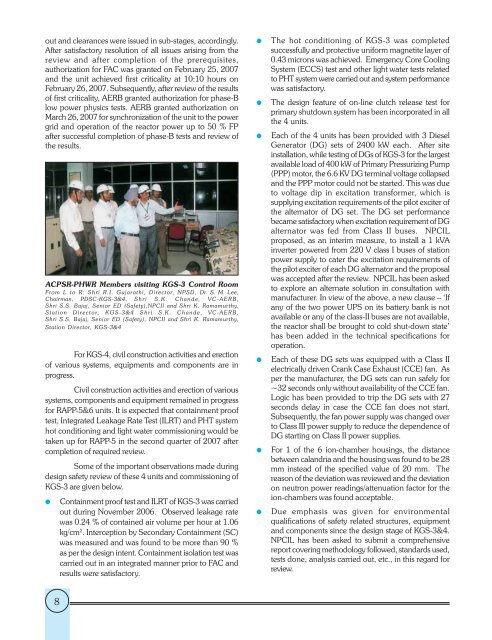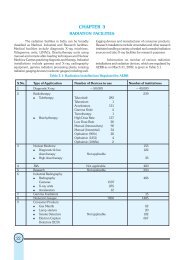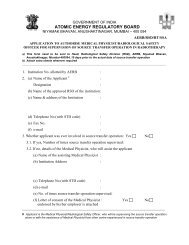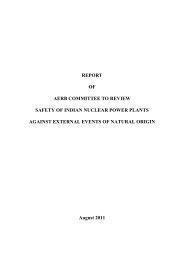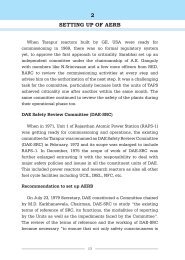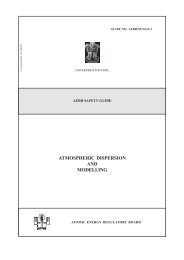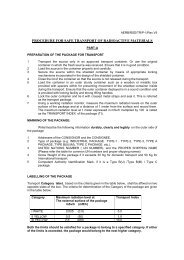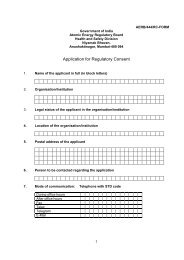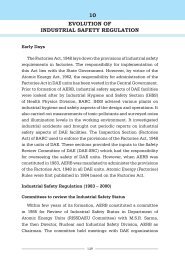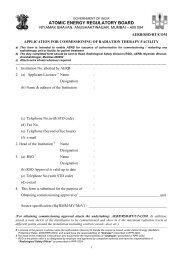here - Atomic Energy Regulatory Board
here - Atomic Energy Regulatory Board
here - Atomic Energy Regulatory Board
Create successful ePaper yourself
Turn your PDF publications into a flip-book with our unique Google optimized e-Paper software.
out and clearances were issued in sub-stages, accordingly.<br />
After satisfactory resolution of all issues arising from the<br />
review and after completion of the prerequisites,<br />
authorization for FAC was granted on February 25, 2007<br />
and the unit achieved first criticality at 10:10 hours on<br />
February 26, 2007. Subsequently, after review of the results<br />
of first criticality, AERB granted authorization for phase-B<br />
low power physics tests. AERB granted authorization on<br />
March 26, 2007 for synchronization of the unit to the power<br />
grid and operation of the reactor power up to 50 % FP<br />
after successful completion of phase-B tests and review of<br />
the results.<br />
ACPSR-PHWR Members visiting KGS-3 Control Room<br />
From L to R: Shri R.I. Gujarathi, Director, NPSD, Dr. S. M. Lee,<br />
Chairman, PDSC-KGS-3&4, Shri S.K. Chande, VC-AERB,<br />
Shri S.S. Bajaj, Senior ED (Safety),NPCIl and Shri K. Ramamurthy,<br />
Station Director, KGS-3&4 Shri S.K. Chande, VC-AERB,<br />
Shri S.S. Bajaj, Senior ED (Safety), NPCIl and Shri K. Ramamurthy,<br />
Station Director, KGS-3&4<br />
For KGS-4, civil construction activities and erection<br />
of various systems, equipments and components are in<br />
progress.<br />
Civil construction activities and erection of various<br />
systems, components and equipment remained in progress<br />
for RAPP-5&6 units. It is expected that containment proof<br />
test, Integrated Leakage Rate Test (ILRT) and PHT system<br />
hot conditioning and light water commissioning would be<br />
taken up for RAPP-5 in the second quarter of 2007 after<br />
completion of required review.<br />
Some of the important observations made during<br />
design safety review of these 4 units and commissioning of<br />
KGS-3 are given below.<br />
●<br />
Containment proof test and ILRT of KGS-3 was carried<br />
out during November 2006. Observed leakage rate<br />
was 0.24 % of contained air volume per hour at 1.06<br />
kg/cm 2 . Interception by Secondary Containment (SC)<br />
was measured and was found to be more than 90 %<br />
as per the design intent. Containment isolation test was<br />
carried out in an integrated manner prior to FAC and<br />
results were satisfactory.<br />
●<br />
●<br />
●<br />
●<br />
●<br />
●<br />
The hot conditioning of KGS-3 was completed<br />
successfully and protective uniform magnetite layer of<br />
0.43 microns was achieved. Emergency Core Cooling<br />
System (ECCS) test and other light water tests related<br />
to PHT system were carried out and system performance<br />
was satisfactory.<br />
The design feature of on-line clutch release test for<br />
primary shutdown system has been incorporated in all<br />
the 4 units.<br />
Each of the 4 units has been provided with 3 Diesel<br />
Generator (DG) sets of 2400 kW each. After site<br />
installation, while testing of DGs of KGS-3 for the largest<br />
available load of 400 kW of Primary Pressurizing Pump<br />
(PPP) motor, the 6.6 KV DG terminal voltage collapsed<br />
and the PPP motor could not be started. This was due<br />
to voltage dip in excitation transformer, which is<br />
supplying excitation requirements of the pilot exciter of<br />
the alternator of DG set. The DG set performance<br />
became satisfactory when excitation requirement of DG<br />
alternator was fed from Class II buses. NPCIL<br />
proposed, as an interim measure, to install a 1 kVA<br />
inverter powered from 220 V class I buses of station<br />
power supply to cater the excitation requirements of<br />
the pilot exciter of each DG alternator and the proposal<br />
was accepted after the review. NPCIL has been asked<br />
to explore an alternate solution in consultation with<br />
manufacturer. In view of the above, a new clause – ‘If<br />
any of the two power UPS on its battery bank is not<br />
available or any of the class-II buses are not available,<br />
the reactor shall be brought to cold shut-down state’<br />
has been added in the technical specifications for<br />
operation.<br />
Each of these DG sets was equipped with a Class II<br />
electrically driven Crank Case Exhaust (CCE) fan. As<br />
per the manufacturer, the DG sets can run safely for<br />
~32 seconds only without availability of the CCE fan.<br />
Logic has been provided to trip the DG sets with 27<br />
seconds delay in case the CCE fan does not start.<br />
Subsequently, the fan power supply was changed over<br />
to Class III power supply to reduce the dependence of<br />
DG starting on Class II power supplies.<br />
For 1 of the 6 ion-chamber housings, the distance<br />
between calandria and the housing was found to be 28<br />
mm instead of the specified value of 20 mm. The<br />
reason of the deviation was reviewed and the deviation<br />
on neutron power readings/attenuation factor for the<br />
ion-chambers was found acceptable.<br />
Due emphasis was given for environmental<br />
qualifications of safety related structures, equipment<br />
and components since the design stage of KGS-3&4.<br />
NPCIL has been asked to submit a comprehensive<br />
report covering methodology followed, standards used,<br />
tests done, analysis carried out, etc., in this regard for<br />
review.<br />
8


